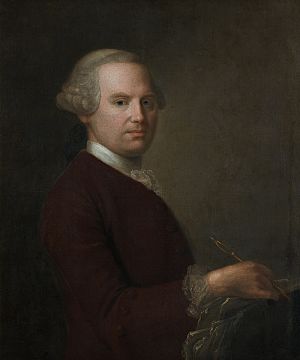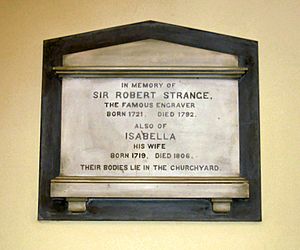Robert Strange (engraver) facts for kids
Sir Robert Strange (born July 14, 1721 – died July 5, 1792) was a famous Scottish engraver. He was a supporter of the Jacobite cause, which meant he supported the return of the Stuart family to the throne of Great Britain. Because of this, he spent some time living outside of Great Britain. However, he eventually made peace with the ruling family, the Hanoverians, and was even knighted by King George III.

Contents
Early Life and Adventures
Robert Strange was born in Kirkwall, Orkney, on July 14, 1721. He was the oldest son of David Strang. Robert first worked in his brother's law office in Edinburgh. But he soon changed paths and became an apprentice to Richard Cooper, the elder, a skilled engraver. He trained with Cooper for six years, learning the art of engraving.
Strange became involved in the Jacobite rising of 1745, a rebellion to put the Stuart prince, Charles Edward Stuart (also known as the Young Pretender), on the throne. While with the Jacobite army in Inverness, he even engraved a special plate for the bank-notes that the Stuart government planned to use. He fought in important battles like Prestonpans and Falkirk Muir. After the Battle of Culloden, where the Jacobites were defeated, Strange had to hide for several months to avoid being captured.
Life in Other Countries
After the government offered a pardon to many Jacobites, Strange went to London. He then traveled to Rouen, France, which was a place where many Jacobite supporters lived in exile. There, he studied how the human body works (anatomy) and learned more about drawing. In 1749, he moved to Paris and continued his training with a famous engraver named Jacques-Philippe Le Bas. He learned a special engraving technique called drypoint. By 1750, he returned to London.
Back in London, Strange worked as an engraver and also bought and sold prints. He had some disagreements with powerful people at court, including Lord Bute. For example, Princess Augusta of Saxe-Gotha wanted him to engrave a portrait of her late husband, Frederick, Prince of Wales. Strange felt the payment offered was too low and turned down the job. Another engraver, William Wynne Ryland, took the job instead and became very popular with King George III.
In 1760, Strange decided to travel to Italy. Even though it was during the Seven Years' War, he managed to get a special pass to travel through France. He met many important artists and thinkers in Italy. He returned to England in 1765, already having a strong reputation as an engraver around the world.
Later Life and Recognition
When Strange came back to London, he showed off the art he had collected. He also wrote detailed descriptions of his works. In 1768, there was a disagreement among artists that led to the creation of the Royal Academy. Strange felt that the Academy was unfair to engravers, especially to him. His rival, Francesco Bartolozzi, was elected to the Academy, even though he was mainly an engraver, supposedly as a painter. Strange, along with other engravers, refused to join the Academy as associate members. In 1775, he wrote a book about his complaints. After this, he moved his family to Paris, where they lived until 1780.
Strange really wanted to engrave a portrait of Queen Henrietta Maria by Anthony van Dyck, which belonged to King George III. He managed to get access to the painting through his friend, Benjamin West. The engraving was published in Paris in 1784. He also engraved a famous painting of King Charles I on his horse. He was even welcomed by Louis XVIII and Marie Antoinette in France. Finally, he finished engraving West's painting called The Apotheosis of the Royal Children in 1786. On January 5, 1787, King George III recognized his great talent and knighted him, giving him the title "Sir."
Death

Sir Robert Strange passed away at his home in London on July 5, 1792. He was buried at St. Paul's, Covent Garden.
Artistic Works
Robert Strange created a portrait of the Young Pretender during the 1745 rebellion. While in France, he engraved famous works like Carl Vanloo's Cupid. In London, his engraved works included the Magdalen and Cleopatra by Guido Reni. He also engraved Apollo and Marsyas by Andrea Sacchi. During his four years in Italy, he made many drawings of paintings, which he later used to create his engravings. Many of his engravings were made and published in Paris. He usually avoided less important work like book illustrations.
Strange often used a technique called drypoint in his engravings. He did not like the stipple engraving method used by artists like Francesco Bartolozzi. He planned to publish a collection of 50 of his most important works. In 1790, eighty sets of these selected prints were put into large books. These books were dedicated to the king and included a portrait of Strange himself. They also had an introduction explaining how engraving had developed over time. Strange mainly chose to engrave works by Italian masters, as well as some by Van Dyck.
Family Life
Before the Jacobite rising of 1745, Strange fell in love with Isabella Lumisden. She was the sister of Andrew Lumisden, a strong Jacobite supporter. They got married secretly in 1747. Isabella's letters were later published, giving a glimpse into their lives. She passed away in 1806.
Robert Strange and Isabella had several children. Their oldest daughter, Mary Bruce Strange (1748–1784), was also artistic. Their oldest son was James Charles Stuart Strange (1753–1840), who became a Member of Parliament. Another son was Thomas Andrew Lumisden Strange. A third son, Robert Montagu, became a major-general in the Madras army.
Gallery
-
Robert Strange, an engraving by the artist himself after Jean-Baptiste Greuze



